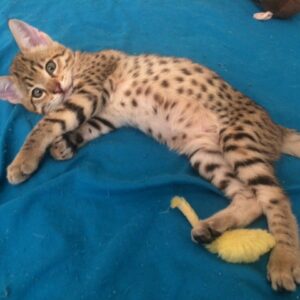Male African Servals
Male African Servals
Physical Description
Adult African servals are slender, agile, and approximately 60 cm in length from shoulder to tail. Males weigh about 9 to 18 kg and females 9 to 13 kg. Their legs and ears are long and considered the largest in the cat family relative to their size. African servals have a coat with copper hue. Their ventral side and some of their facial features are white. They have black spots and stripes, which vary among each individual in size and placement. Individuals that originated from grasslands tend to have larger spots than those found in forests. Markings run from the top of the head between the ears and continue down the back breaking into four distinct lines. Upon reaching the shoulders, the lines break and scatter into spots along the same path of the stripes. Eventually reaching the rear of the animal, the spots elongate perpendicularly and merge to form the rings of the tail. The tip of the tail is black. The back of the ears are black with a white line between them. Occasionally, melanistic servals have been observed.
Behavior
African servals hunt during early morning and late afternoon and rest at mid-day and occasionally at night. Hunting movements range about 2.4 km per day and about half that distance per night. During the dry season, hunting movements decrease. Best concealed in the tall grass, African servals slink in open areas until cover is found again. Territory is marked in several ways, all of which increase when another serval is present or detected. Methods of marking include spraying urine, rubbing the side of the face (which contain scent glands) on the ground or brush, defecation, and marking/scratching the ground. Servals are not social, but in some cases, when a male and female encounter each other, they may travel, hunt, and rest together for short periods. Females tend to be more active than males.





